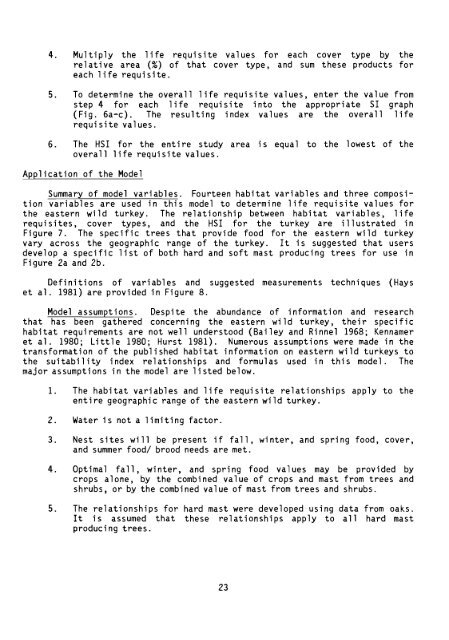habitat suitability index models: eastern wild turkey - USGS National ...
habitat suitability index models: eastern wild turkey - USGS National ...
habitat suitability index models: eastern wild turkey - USGS National ...
Create successful ePaper yourself
Turn your PDF publications into a flip-book with our unique Google optimized e-Paper software.
4. Multiply the life requisite values for each cover type by the<br />
relative area (%) of that cover type, and sum these products for<br />
each life requisite.<br />
5. To determine the overall life requisite values, enter the value from<br />
step 4 for each life requisite into the appropriate SI graph<br />
(Fig. 6a-c). The resulting <strong>index</strong> values are the overall life<br />
requisite values.<br />
6. The HSl for the entire study area is equal to the lowest of the<br />
overall life requisite values.<br />
Application of the Model<br />
Summary of model variables. Fourteen <strong>habitat</strong> variables and three composition<br />
variables are used in this model to determine life requisite values for<br />
the <strong>eastern</strong> <strong>wild</strong> <strong>turkey</strong>. The relationship between <strong>habitat</strong> variables, life<br />
requisites, cover types, and the HSl for the <strong>turkey</strong> are illustrated in<br />
Figure 7. The spec ifi c trees that provi de food for the <strong>eastern</strong> wi 1d <strong>turkey</strong><br />
vary across the geographic range of the <strong>turkey</strong>. It is suggested that users<br />
develop a specific list of both hard and soft mast producing trees for use in<br />
Figure 2a and 2b.<br />
Definitions of variables and suggested measurements techniques (Hays<br />
et al. 1981) are provided in Figure 8.<br />
Model assumptions. Despite the abundance of information and research<br />
that has been gathered concerning the <strong>eastern</strong> <strong>wild</strong> <strong>turkey</strong>, their specific<br />
<strong>habitat</strong> requirements are not well understood (Bailey and Rinnel 1968; Kennamer<br />
et al. 1980; Little 1980; Hurst 1981). Numerous assumptions were made in the<br />
transformation of the published <strong>habitat</strong> information on <strong>eastern</strong> <strong>wild</strong> <strong>turkey</strong>s to<br />
the <strong>suitability</strong> <strong>index</strong> relationships and formulas used in this model. The<br />
major assumptions in the model are listed below.<br />
1. The <strong>habitat</strong> variables and life requisite relationships apply to the<br />
entire geographic range of the <strong>eastern</strong> <strong>wild</strong> <strong>turkey</strong>.<br />
2. Water is not a limiting factor.<br />
3. Nest sites will be present if fall, winter, and spring food, cover,<br />
and summer food! brood needs are met.<br />
4. Optimal fall, winter, and spring food values may be provided by<br />
crops alone, by the combined value of crops and mast from trees and<br />
shrubs, or by the combined value of mast from trees and shrubs.<br />
5. The relationships for hard mast were developed using data from oaks.<br />
It is assumed that these relationships apply to all hard mast<br />
producing trees.<br />
23

















